Research Progress and Hotspot Evolution Analysis of Landscape Microclimate: Visual Analysis Based on CNKI and WOS
Abstract
1. Introduction
2. Data Sources and Methods
2.1. Data Sources
2.2. Data Analysis
3. Results and Analysis
3.1. Post Analysis
3.2. Posting Team Analysis
3.3. Posting Organization Analysis
3.4. Research Hotspots and Trend Analysis
3.4.1. Analysis of Literature Co-Citation
Microclimate Simulation
Urban Design
Thermal Sensation
3.4.2. Core Keywords and Time Sequence Evolution Characteristics Analysis
4. Discussions
5. Conclusions
Author Contributions
Funding
Institutional Review Board Statement
Informed Consent Statement
Data Availability Statement
Conflicts of Interest
References
- Fang, Q.; Qian, L.; Lu, Z. Carbon Emissions Estimation for Achieving Carbon Peaking and Carbon Neutrality in China. Environ. Prot. 2021, 49, 49–54. [Google Scholar] [CrossRef]
- Liu, C. Functional Positioning and Coping Strategies of Landscape Architecture in the Context of Climate Change. Landsc. Archit. 2020, 27, 75–79. [Google Scholar] [CrossRef]
- Wu, S. Research on Microclimate Effect of Urban Green Space and Its Impact on Human Comfort. Masters’ Thesis, Beijing Forestry University, Beijing, China, 2019; pp. 12–15. [Google Scholar]
- Speak, A.; Montagnani, L.; Wellstein, C.; Zerbe, S. The influence of tree traits on urban ground surface shade cooling. Landsc. Urban Plan. 2020, 197, 103748. [Google Scholar] [CrossRef]
- Rui, L.; Buccolieri, R.; Gao, Z.; Gatto, E.; Ding, W. Study of the effect of green quantity and structure on thermal comfort and air quality in an urban-like residential district by ENVI-met modelling. Build. Simul. 2019, 12, 183–194. [Google Scholar] [CrossRef]
- Teshnehdel, S.; Akbari, H.; Di Giuseppe, E.; Brown, R.D. Effect of tree cover and tree species on microclimate and pedestrian comfort in a residential district in Iran. Build. Environ. 2020, 178, 106899. [Google Scholar] [CrossRef]
- Yang, X. Study on the Influence of Microclimate on Tourist Volume in Scenic Areas under the Environmental Behavior Perspective. Ph.D. Thesis, Huaqiao University, Quanzhou, China, 2020; pp. 17–21. [Google Scholar]
- Dong, L.; Zhang, M. Characterization of landscape and urban microclimate research based on CiteSpace. Landsc. Archit. 2018, 25, 32–37. [Google Scholar] [CrossRef]
- Chen, C. CiteSpace II: Detecting and visualizing emerging trends and transient patterns in scientific literature. J. Am. Soc. Inf. Sci. Technol. 2006, 57, 359–377. [Google Scholar] [CrossRef]
- Chen, Y.; Chen, C.; Liu, Z.; Hu, Z.; Wang, X. Methodological functions of CiteSpace knowledge graphs. Scientol. Res. 2015, 33, 242–253. [Google Scholar] [CrossRef]
- Tang, G.; Zhang, W. Development and analysis of co-word analysis research at home and abroad. Libr. Intell. Work. 2014, 58, 138–145. [Google Scholar] [CrossRef]
- Li, J.; Song, C.; Cao, L.; Zhu, F.; Meng, X.; Wu, J. Impacts of landscape structure on surface urban heat islands: A case study of Shanghai, China. Remote Sens. Environ. 2011, 115, 3249–3263. [Google Scholar] [CrossRef]
- Zhai, D. A study of the interplay between the U.S.-China bilateral climate relationship and the United Nations Framework Convention on Climate Change process. Pacific J. 2022, 30, 1–12. [Google Scholar] [CrossRef]
- Guo, X.; Bao, Z.; Wu, F.; Yang, S.; Yan, H. Study on the influence of street visibility factors on microclimate and thermal comfort of urban street canyons in summer afternoons. Chin. Gard. 2021, 37, 71–76. [Google Scholar] [CrossRef]
- Yan, H. Study on the environmental effects of microclimate in urban park green space and its influencing factors. Ph.D. Thesis, Beijing Forestry University, Beijing, China, 2014; pp. 22–23. [Google Scholar]
- Chen, R.Z.; Dong, L. A Brief Review of Foreign Microclimate Comfort Research and Implications. Chin. Gard. 2009, 25, 81–83. [Google Scholar]
- Liu, B.; Peng, X. Progress and Insights on Microclimate Comfortability of Urban Streets. Chin. Gard. 2019, 35, 57–62. [Google Scholar] [CrossRef]
- Mei, I.; Liu, B. Analysis of winter microclimate perception of landscape garden spaces in Shanghai settlements. Chin. Gard. 2017, 33, 12–17. [Google Scholar]
- Jim, C.Y.; He, H. Coupling heat flux dynamics with meteorological conditions in the green roof ecosystem. Ecol. Eng. 2010, 36, 1052–1063. [Google Scholar] [CrossRef]
- Ferdyn-Grygierek, J. Monitoring of indoor air parameters in large museum exhibition halls with and without air-conditioning systems. Build. Environ. 2016, 107, 113–126. [Google Scholar] [CrossRef]
- Middel, A.; Selover, N.; Hagen, B.; Chhetri, N. Impact of shade on outdoor thermal comfort-a seasonal field study in Tempe, Arizona. Int. J. Biometeorol. 2016, 60, 1849–1861. [Google Scholar] [CrossRef]
- Middel, A.; Krayenhoff, E.S. Micrometeorological determinants of pedestrian thermal exposure during record-breaking heat in Tempe, Arizona: Introducing the MaRTy observational platform. Sci. Total Environ. 2019, 687, 137–151. [Google Scholar] [CrossRef]
- Morakinyo, T.E.; Kong, L.; Lau, K.K.-L.; Yuan, C.; Ng, E. A study on the impact of shadow-cast and tree species on in-canyon and neighborhood’s thermal comfort. Build. Environ. 2017, 115, 1–17. [Google Scholar] [CrossRef]
- Wu, S.; Wang, X.; Liu, T.; Wang, J.; Yuan, X.; He, Y.; Kong, W. Progress of wetland restoration research based on CiteSpace. J. Ecol. 2022, 42, 1224–1239. [Google Scholar]
- Wei, B.; Hu, X.; Zhu, M.; Peng, L.; Xu, K. Hot spots and trends of green ecological network research in China based on CiteSpace. Econ. Geogr. 2021, 41, 174–183. [Google Scholar] [CrossRef]
- Middel, A.; Haeb, K.; Brazel, A.J.; Martin, C.A.; Guhathakurta, S. Impact of urban form and design on mid-afternoon microclimate in Phoenix Local Climate Zones. Landsc. Urban Plan. 2014, 122, 16–28. [Google Scholar] [CrossRef]
- Wang, Y.; Berardi, U.; Akbari, H. Comparing the effects of urban heat island mitigation strategies for Toronto, Canada. Energy Build. 2016, 114, 2–19. [Google Scholar] [CrossRef]
- Santamouris, M.; Gaitani, N.; Spanou, A.; Saliari, M.; Giannopoulou, K.; Vasilakopoulou, K.; Kardomateas, T. Using cool paving materials to improve microclimate of urban areas—Design realization and results of the flisvos project. Build. Environ. 2012, 53, 128–136. [Google Scholar] [CrossRef]
- Ghaffarianhoseini, A.; Berardi, U.; Ghaffarianhoseini, A. Thermal performance characteristics of unshaded courtyards in hot and humid climates. Build. Environ. 2015, 87, 154–168. [Google Scholar] [CrossRef]
- Santamouris, M. Cooling the cities—A review of reflective and green roof mitigation technologies to fight heat island and improve comfort in urban environments. Sol. Energy 2014, 103, 682–703. [Google Scholar] [CrossRef]
- Konarska, J.; Uddling, J.; Holmer, B.; Lutz, M.; Lindberg, F.; Pleijel, H.; Thorsson, S. Transpiration of urban trees and its cooling effect in a high latitude city. Int. J. Biometeorol. 2016, 60, 159–172. [Google Scholar] [CrossRef]
- Potchter, O.; Cohen, P.; Lin, T.-P.; Matzarakis, A. Outdoor human thermal perception in various climates: A comprehensive review of approaches, methods and quantification. Sci. Total Environ. 2018, 631, 390–406. [Google Scholar] [CrossRef]
- Silva, C.; Uwai, D.A.; Ribeiro, P.A.; Oliveira, I. Computer Simulation of Three Mesoclimatic Urban the Federal District of Brazil. Procedia Eng. 2016, 169, 280–288. [Google Scholar] [CrossRef]
- Tsoka, S.; Tsikaloudaki, A.; Theodosiou, T. Analyzing the ENVI-met microclimate model’s performance and assessing cool materials and urban vegetation applications—A review. Sustain. Cities Soc. 2018, 43, 55–76. [Google Scholar] [CrossRef]
- Fanger, P.O. Thermal comfort: Analysis and Applications in Environmental Engineering; Danish Technical Press: Copenhagen, Denmark, 1970; pp. 25–26. [Google Scholar]
- Watanabe, S.; Nagano, K.; Ishii, J.; Horikoshi, T. Evaluation of outdoor thermal comfort in sunlight, building shade, and pergola shade during summer in a humid subtropical region. Build. Environ. 2014, 82, 556–565. [Google Scholar] [CrossRef]
- Sanusi, R.; Johnstone, D.; May, P.; Livesley, S.J. Microclimate benefits that different street tree species provide to sidewalk pedestrians relate to differences in Plant Area Index. Landsc. Urban Plan. 2017, 157, 502–511. [Google Scholar] [CrossRef]
- Jankowska, A.; Kozakiewicz, P. Comparison of thermal properties of selected wood species intended to woodwork windows production. For. Wood Technol. 2014, 85, 101–105. [Google Scholar]
- Huang, L.; Huang, H.; Xiang, D.; Zhu, J. The diurnal change of air temperature in four types of land cover and urban heat island effect in Nanjing, China. Ecol. Environ. 2007, 16, 1411–1420. [Google Scholar]
- Klemm, W.; Heusinkveld, B.G.; Lenzholzer, S.; van Hove, B. Street greenery and its physical and psychological impact on thermal comfort. Landsc. Urban Plan. 2015, 138, 87–98. [Google Scholar] [CrossRef]
- Zhu, L.; Meng, X.; Zhao, R.; Xian, G.; Kou, Y. An analysis of the current status of co-citation analysis research at home and abroad. Digit. Libr. Forum 2015, 40–45. [Google Scholar]
- Wang, M. Research on bursting Analysis Based on bursting Detection for Topic bursting. Intell. Sci. 2016, 34, 36–39. [Google Scholar] [CrossRef]
- Tian, S. Study on the Thermal Comfort of Street Green Space in the Historical District of Wu Avenue, Tianjin based on Envi-met. Masters’ Thesis, Tianjin University, Tianjin, China, 2020; pp. 21–23. [Google Scholar]
- Lu, J. Microclimate Design of Xiamen Urban Park. Masters’ Thesis, Huaqiao University, Quanzhou, China, 2018; pp. 6–8. [Google Scholar]
- Li, J. Research on Landscape Design Strategy of Harbin University Based on Microclimate Improvement. Masters’ Thesis, Harbin Institute of Technology, Harbin, China, 2018; pp. 16–18. [Google Scholar]
- Guo, Y.; Wang, A. Study on the spatial characteristics of transitional seasons of urban squares in semi-arid areas on the regulation effect of microclimate. Chin. Gard. 2021, 37, 107–112. [Google Scholar] [CrossRef]
- Xin, Z.; Ciao, Z.; Cheng, Y. Strategies for improving the quality of outdoor space environment in old neighborhoods in cold cities—A case study of Jichai neighborhood in Changchun. Planner 2020, 36, 58–63. [Google Scholar]
- Li, J. Summer Thermal Environment of Building Courtyard in Xiamen Campus of Huaqiao University. Masters’ Thesis, Huaqiao University, Quanzhou, China, 2013; pp. 13–14. [Google Scholar]
- Li, Y.N.; Song, Y.; Cho, D.; Han, Z. Zonal classification of microclimates and their relationship with landscape design parameters in an urban park. Landsc. Ecol. Eng. 2019, 15, 265–276. [Google Scholar] [CrossRef]
- Srivanit, M.; Hokao, K. Evaluating the cooling effects of greening for improving the outdoor thermal environment at an institutional campus in the summer. Build. Environ. 2013, 66, 158–172. [Google Scholar] [CrossRef]
- Perini, K.; Magliocco, A. Effects of vegetation, urban density, building height, and atmospheric conditions on local temperatures and thermal comfort. Urban For. Urban Green. 2014, 13, 495–506. [Google Scholar] [CrossRef]
- Ng, E.; Chen, L.; Wang, Y.; Yuan, C. A study on the cooling effects of greening in a high-density city: An experience from Hong Kong. Build. Environ. 2012, 47, 256–271. [Google Scholar] [CrossRef]
- Yang, X.; Zhao, L.; Bruse, M.; Meng, Q. Evaluation of a microclimate model for predicting the thermal behavior of different ground surfaces. Build. Environ. 2013, 60, 93–104. [Google Scholar] [CrossRef]
- Litti, G.; Audenaert, A. An integrated approach for indoor microclimate diagnosis of heritage and museum buildings: The main exhibition hall of Vleeshuis museum in Antwerp. Energy Build. 2018, 162, 91–108. [Google Scholar] [CrossRef]
- Xiao, X.; Ding, M.; Dong, L.; Wang, Y.; Wang, L. Study on the influence of park characteristics and distance from water on its summer temperature and humidity effect: A case study of Suzhou Industrial Park. Chin. Gard. 2021, 37, 48–53. [Google Scholar] [CrossRef]
- Wang, H.; Wang, Y.; Wang, T.; Wang, J.; Lei, Y. Influence of green space structure on climate regulators in Zhengzhou City and its implications. Ecol. Sci. 2022, 41, 98–106. [Google Scholar] [CrossRef]
- Shan, Y.; Cai, X.; Zhang, D. Study of microclimate suitable spatial patterns in waterfront settlements in cold regions: The case of Tianjin Tianjiahu settlement. Build. Sci. 2022, 38, 82–88. [Google Scholar] [CrossRef]
- Geng, H.; Wei, X.; Zhang, M.; Li, Q. A study on the influence of Envi-met vegetation and buildings on microclimate: The case of Nanjing Agricultural University. J. Beijing For. Univ. 2020, 42, 115–124. [Google Scholar]
- Xue, S.; Feng, J.; Xiao, Y. Thermal environment simulation analysis of the garden space of Yu Yin Shan Fang, a famous garden in Lingnan. Chin. Gard. 2016, 32, 23–27. [Google Scholar]
- Hu, Y.; Mark, M. A comprehensive simulation study on the effects of urban street greening on air quality and microclimate. J. Ecol. 2021, 41, 1314–1331. [Google Scholar]
- Fan, Y.; Dong, L. Analysis of winter microclimate in “single arch” shaded street valley space of Xi’an city. Chin. Gard. 2022, 38, 115–120. [Google Scholar] [CrossRef]
- Huang, Y.; Fu, W.; Chen, J.; Dong, J.; Wang, M. Study on the influence of plant community characteristics on microclimate in summer park shade space. Chin. Gard. 2022, 38, 118–123. [Google Scholar] [CrossRef]
- Shashua-Bar, L.; Pearlmutter, D.; Erell, E. The influence of trees and grass on outdoor thermal comfort in a hot-arid environment. Int. J. Climatol. 2011, 31, 1498–1506. [Google Scholar] [CrossRef]
- Lenzholzer, S.; Koh, J. Immersed in microclimatic space: Microclimate experience and perception of spatial configurations in Dutch squares. Landsc. Urban Plan. 2010, 95, 1–15. [Google Scholar] [CrossRef]
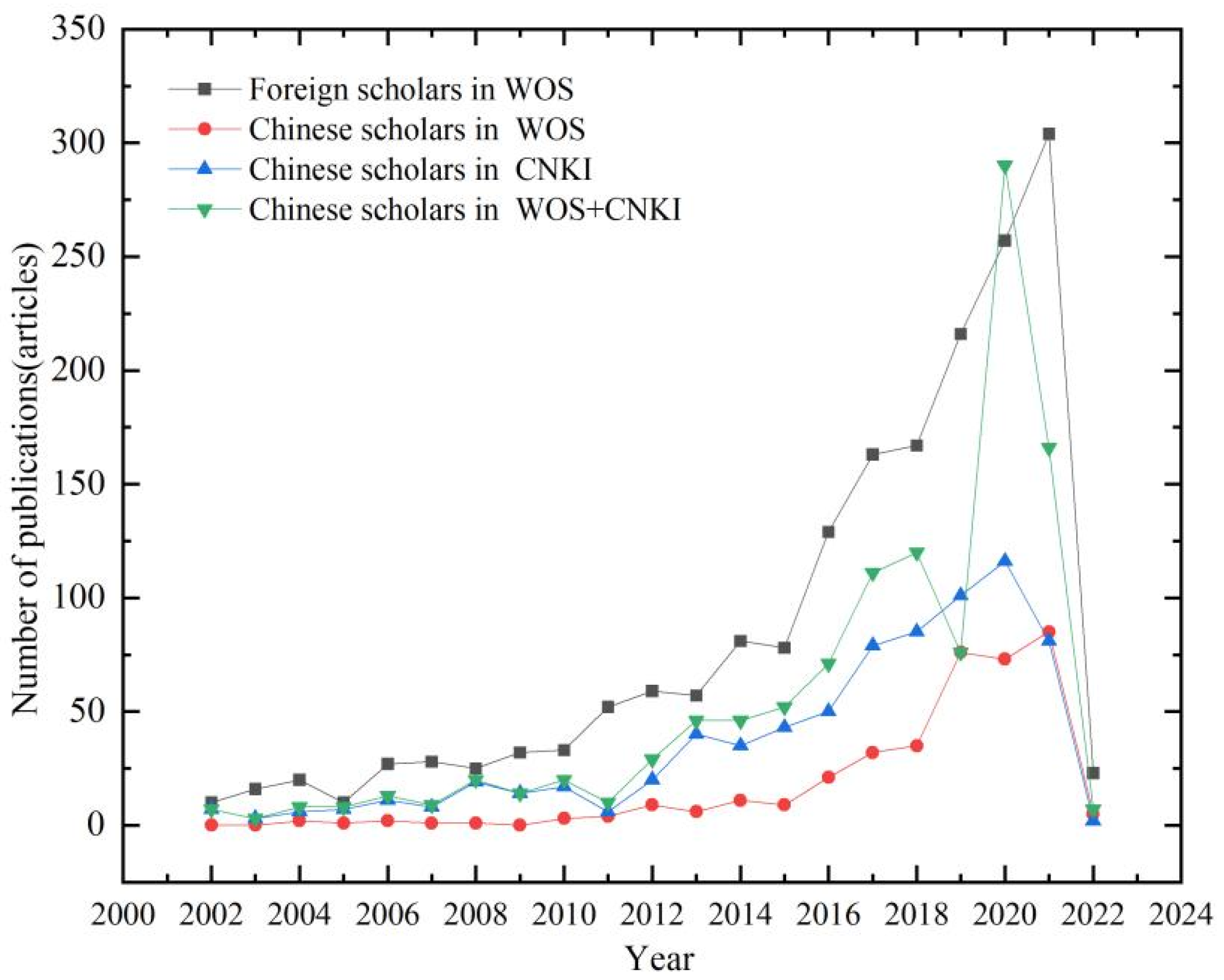

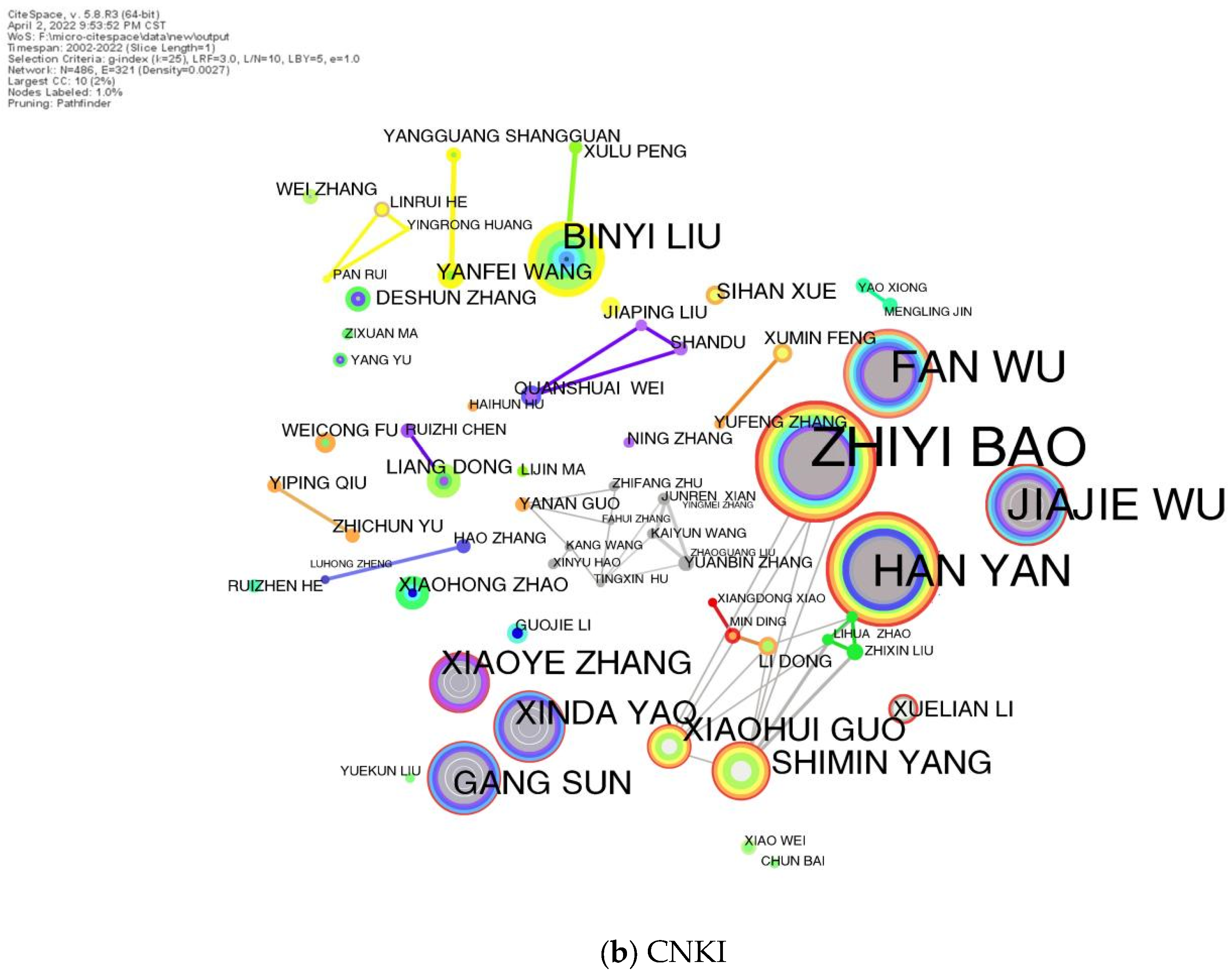
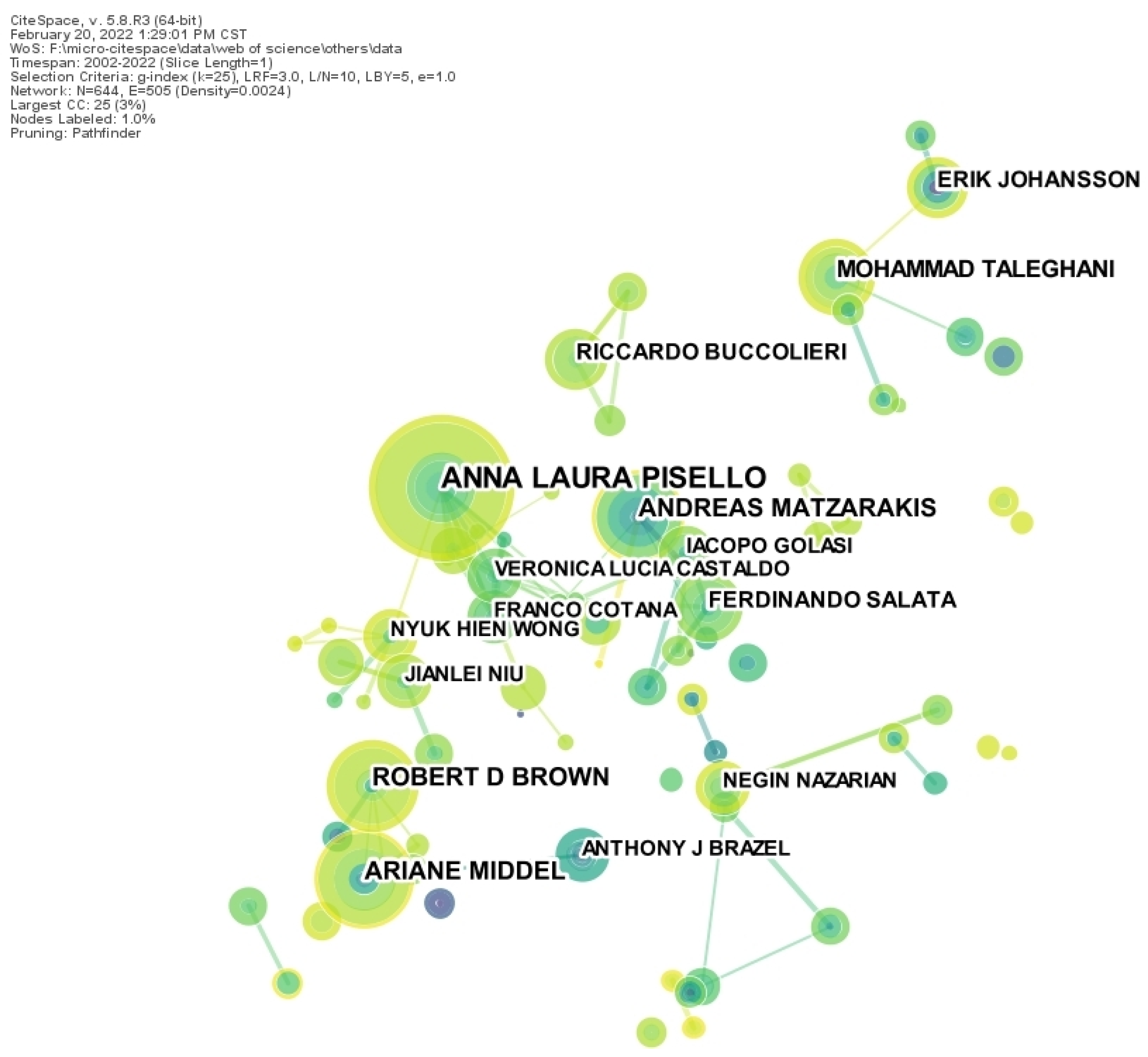
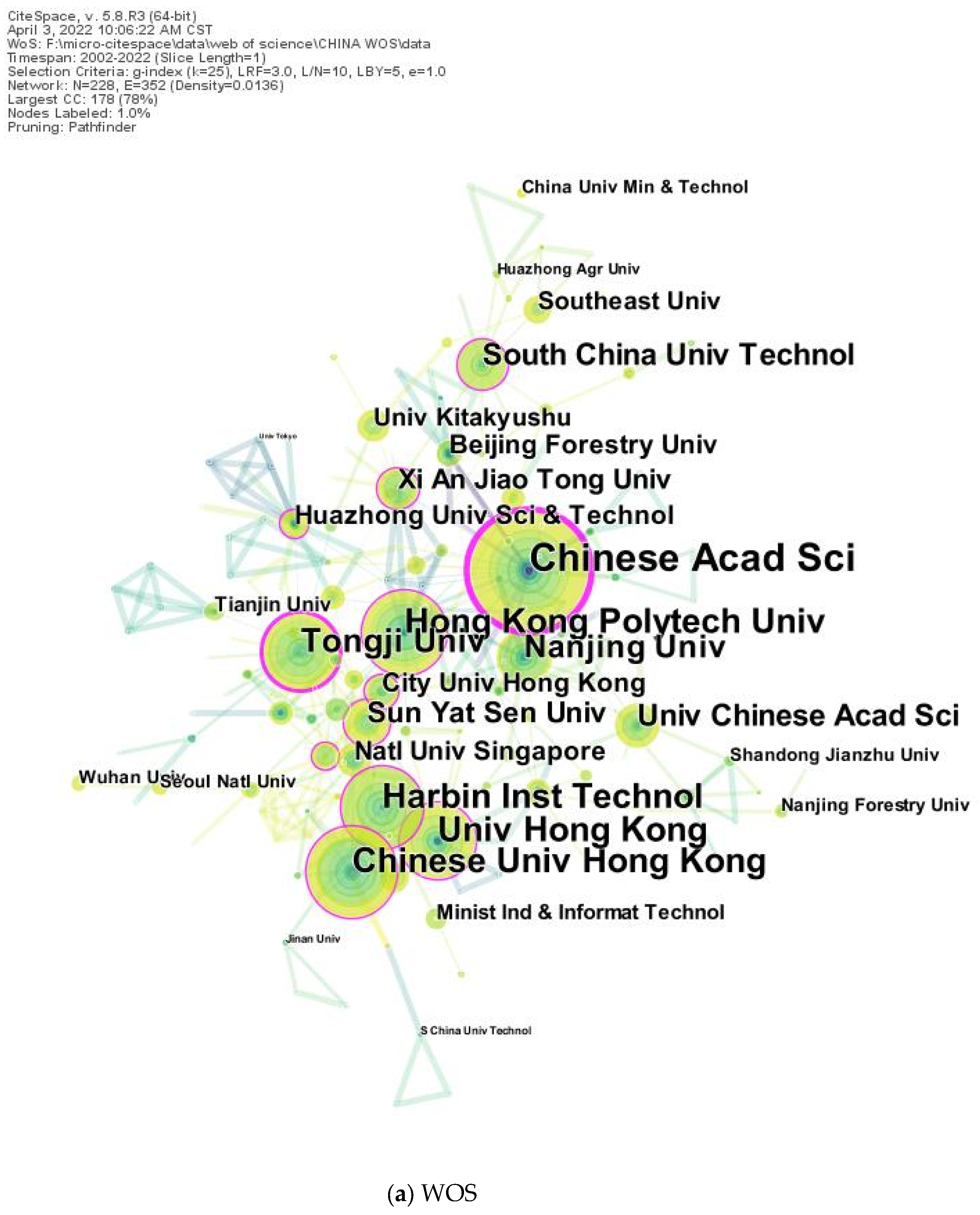
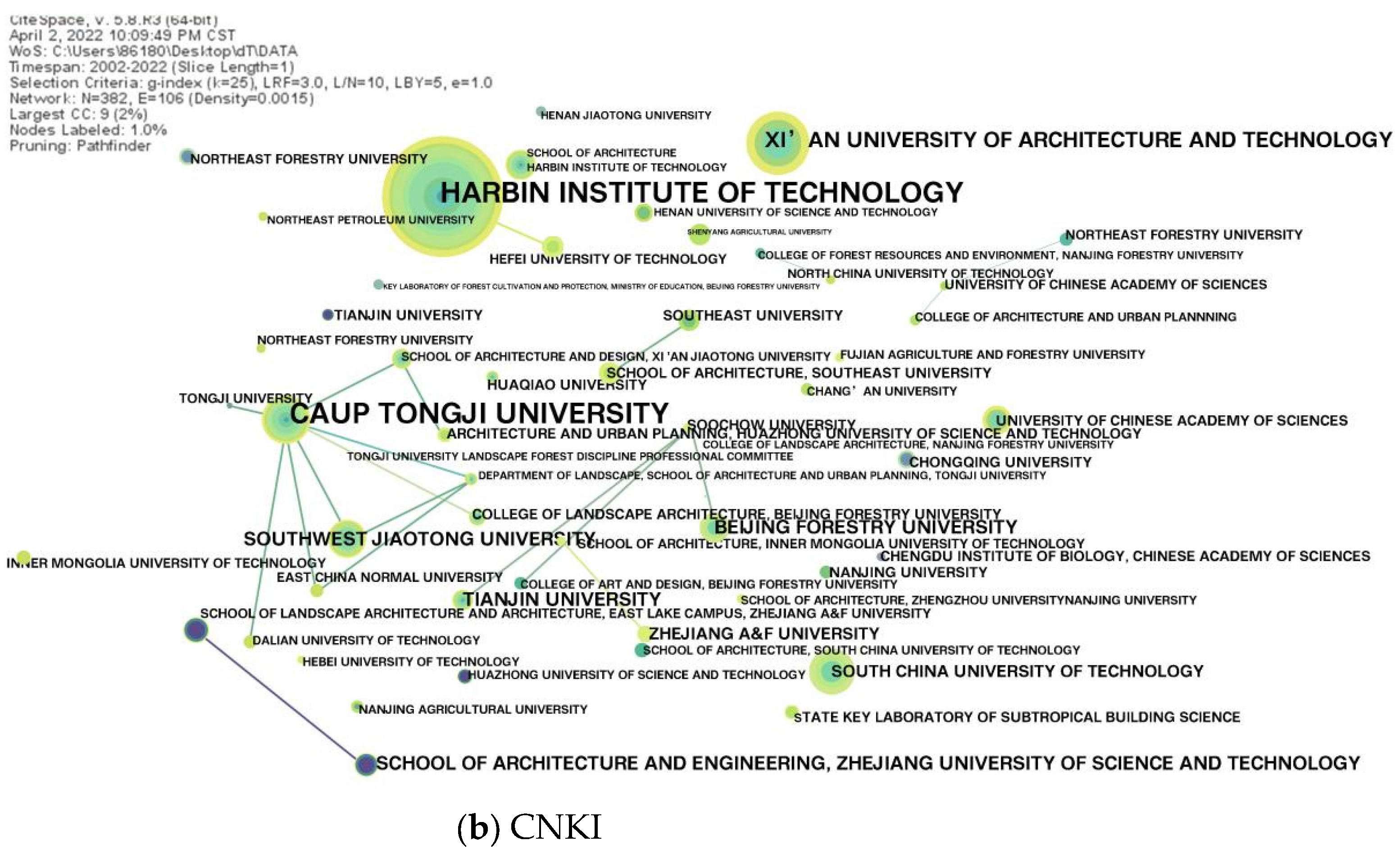
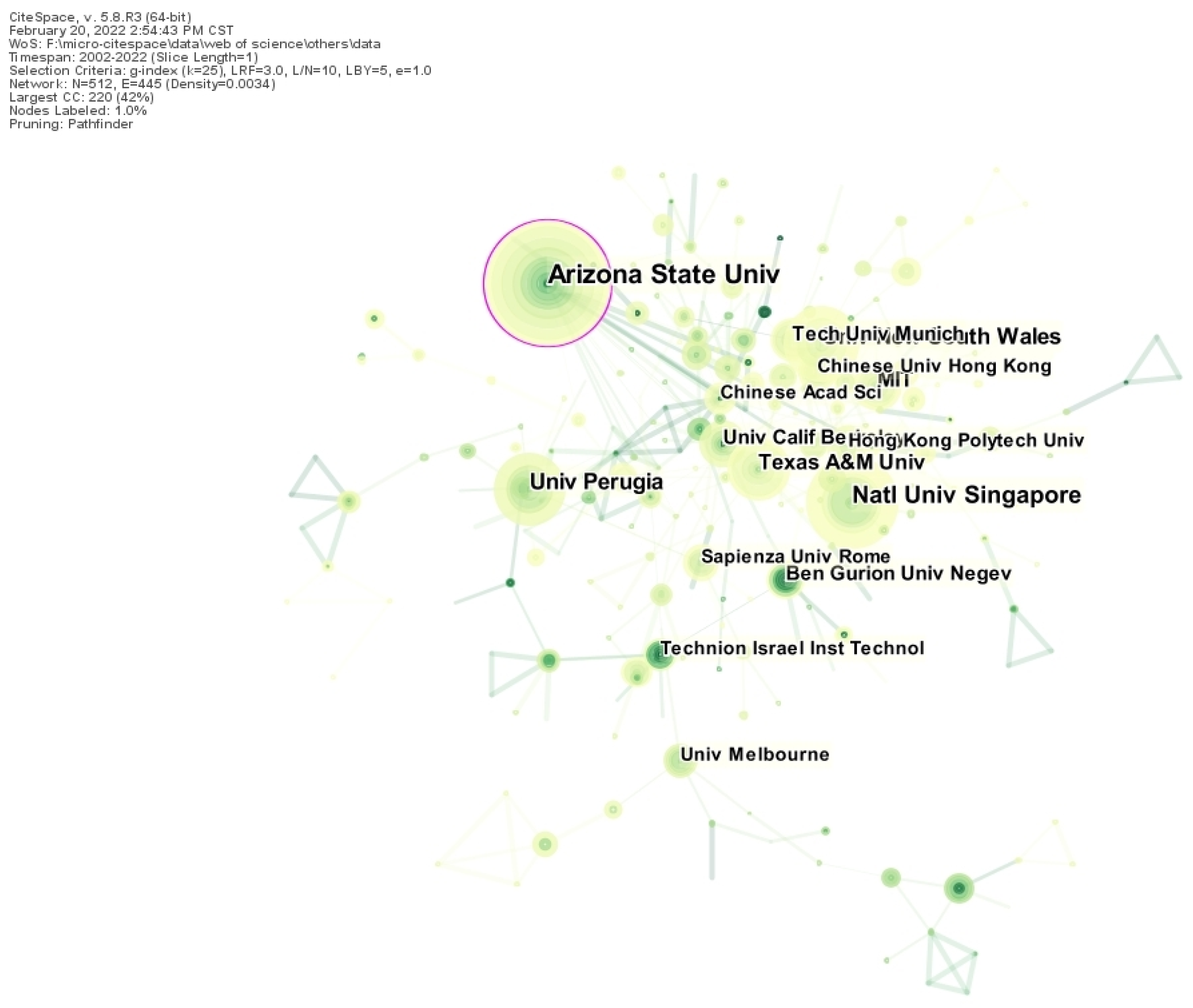
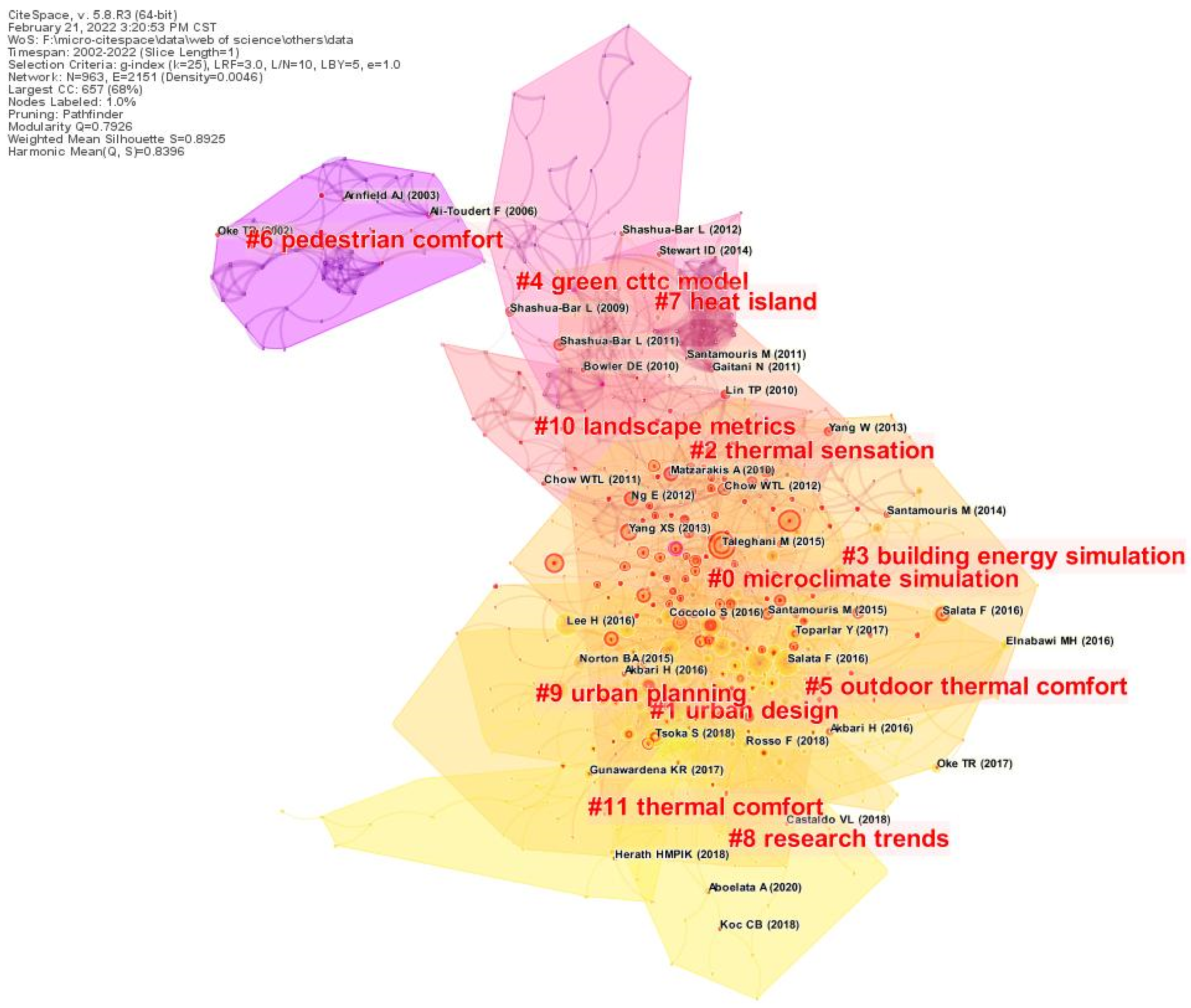
| Cluster (CNKI) | High-Frequency Keywords | Cluster (China-Wos) | High-Frequency Keywords |
|---|---|---|---|
| #0 Microclimate | Microclimate; Plant community; Optimization strategy; Temperature and humidity; Building energy efficiency; Building energy consumption; Energy-efficient design; Plant gardening; Wind speed; Ficus fine-leaved; | #0 CFD | Thermal comfort; Outdoor thermal comfort; Numerical simulation; Cfd; Ventilation; Air; Flow; Cfd simulation; Air flow; Sky view factor; |
| #1 Microclimate effect | Microclimate effect; Habitat; Residential architecture; Urban forest; Vertical greening; Small habitat; Street space; Guangzhou city; Effect; Pruning; | #1 Outdoor thermal comfort | Design; Simulation; Comfort; Performance; Street canyon; Energy; Mitigation; Urban; Summer; Outdoor; |
| #2 Landscape garden | Landscape gardening; Spatial form; Thermal comfort; Urban square; Traditional village; Urban street; Urban settlement; Summer; Winter; Settlement; | #2 Urban heat mitigation | Energy use; Balance; Solar radiation; Nonwoven; Street; Scale; Island mitigation strategy; Shade tree; Residential district; Classification; |
| #3 Ecology | Hilly area; Ecological architecture; Integrated characteristics; Interactive space; Energy saving; Ecology; Environment; Primary and secondary schools; Climatic conditions; Climate; | #3 Microclimate effect | 2003 heat wave; Green space; Air quality; Arrangement; Health; Shaw; Temperature; CO2 Emission; Heat island; Pattern; |
| #4 Thermal comfort | Xiamen; Utci; Residential district; Waterscape design; Building layout; Climate design; Nanjing; Revival design; Low-energy building; Environment; | #4 Landscape metrics | Geometry; Forest amenity; Lodz; Graphene ink; Impervious surface; Heat island intensity; Land use; City; Aspect ratio; Valuation; |
| #5 Human comfort | Optimization study; Physical activity; High-density settlement; Plaza; Micro environment; Comfort; Landscaping; Simulation analysis; Cold land; Experience; | #5 Outdoor thermal comfort | Behavior; Human health; Space; Urban space; Adaptive model; Sensation; Canopy stomatal conductance; American crow; Climate index utci; Heat wave; |
| Keywords Burst Information of Chinese Scholars in Foreign Journals | |||||
| Keywords | Year | Strength | Begin | End | 2002–2022 |
| rain forest | 2002 | 7.15 | 2002 | 2016 | ▃ ▃ ▃ ▃ ▃ ▃ ▃ ▃ ▃ ▃ ▃ ▃ ▃ ▃ ▃ ▂ ▂ ▂ ▂ ▂ ▂ |
| community | 2002 | 4.97 | 2003 | 2016 | ▂ ▃ ▃ ▃ ▃ ▃ ▃ ▃ ▃ ▃ ▃ ▃ ▃ ▃ ▃ ▂ ▂ ▂ ▂ ▂ ▂ |
| ecosystem | 2002 | 3.91 | 2003 | 2014 | ▂ ▃ ▃ ▃ ▃ ▃ ▃ ▃ ▃ ▃ ▃ ▃ ▃ ▂ ▂ ▂ ▂ ▂ ▂ ▂ ▂ |
| landscape | 2002 | 4.52 | 2004 | 2014 | ▂ ▂ ▃ ▃ ▃ ▃ ▃ ▃ ▃ ▃ ▃ ▃ ▃ ▂ ▂ ▂ ▂ ▂ ▂ ▂ ▂ |
| behavior | 2002 | 3.7 | 2005 | 2014 | ▂ ▂ ▂ ▃ ▃ ▃ ▃ ▃ ▃ ▃ ▃ ▃ ▃ ▂ ▂ ▂ ▂ ▂ ▂ ▂ ▂ |
| water | 2002 | 3.6 | 2007 | 2009 | ▂ ▂ ▂ ▂ ▂ ▃ ▃ ▃ ▂ ▂ ▂ ▂ ▂ ▂ ▂ ▂ ▂ ▂ ▂ ▂ ▂ |
| soil | 2002 | 6.04 | 2009 | 2016 | ▂ ▂ ▂ ▂ ▂ ▂ ▂ ▃ ▃ ▃ ▃ ▃ ▃ ▃ ▃ ▂ ▂ ▂ ▂ ▂ ▂ |
| plant | 2002 | 4.44 | 2009 | 2013 | ▂ ▂ ▂ ▂ ▂ ▂ ▂ ▃ ▃ ▃ ▃ ▃ ▂ ▂ ▂ ▂ ▂ ▂ ▂ ▂ ▂ |
| pattern | 2002 | 3.8 | 2009 | 2015 | ▂ ▂ ▂ ▂ ▂ ▂ ▂ ▃ ▃ ▃ ▃ ▃ ▃ ▃ ▂ ▂ ▂ ▂ ▂ ▂ ▂ |
| growth | 2002 | 6.55 | 2010 | 2015 | ▂ ▂ ▂ ▂ ▂ ▂ ▂ ▂ ▃ ▃ ▃ ▃ ▃ ▃ ▂ ▂ ▂ ▂ ▂ ▂ ▂ |
| temperature | 2002 | 4.71 | 2010 | 2011 | ▂ ▂ ▂ ▂ ▂ ▂ ▂ ▂ ▃ ▃ ▂ ▂ ▂ ▂ ▂ ▂ ▂ ▂ ▂ ▂ ▂ |
| surface | 2002 | 3.63 | 2011 | 2017 | ▂ ▂ ▂ ▂ ▂ ▂ ▂ ▂ ▂ ▃ ▃ ▃ ▃ ▃ ▃ ▃ ▂ ▂ ▂ ▂ ▂ |
| land use | 2002 | 4.25 | 2012 | 2016 | ▂ ▂ ▂ ▂ ▂ ▂ ▂ ▂ ▂ ▂ ▃ ▃ ▃ ▃ ▃ ▂ ▂ ▂ ▂ ▂ ▂ |
| outdoor | 2002 | 4.36 | 2018 | 2019 | ▂ ▂ ▂ ▂ ▂ ▂ ▂ ▂ ▂ ▂ ▂ ▂ ▂ ▂ ▂ ▂ ▃ ▃ ▂ ▂ ▂ |
| energy performance | 2002 | 3.92 | 2018 | 2019 | ▂ ▂ ▂ ▂ ▂ ▂ ▂ ▂ ▂ ▂ ▂ ▂ ▂ ▂ ▂ ▂ ▃ ▃ ▂ ▂ ▂ |
| summer | 2002 | 3.97 | 2019 | 2020 | ▂ ▂ ▂ ▂ ▂ ▂ ▂ ▂ ▂ ▂ ▂ ▂ ▂ ▂ ▂ ▂ ▂ ▃ ▃ ▂ ▂ |
| envi-met | 2002 | 4.44 | 2020 | 2022 | ▂ ▂ ▂ ▂ ▂ ▂ ▂ ▂ ▂ ▂ ▂ ▂ ▂ ▂ ▂ ▂ ▂ ▂ ▃ ▃ ▃ |
| Keyword Burst Information of Chinese Scholars in Domestic Journals | |||||
| Keywords | Year | Strength | Begin | End | 2002–2022 |
| microclimate | 2002 | 7.83 | 2006 | 2009 | ▂ ▂ ▂ ▂ ▃ ▃ ▃ ▃ ▂ ▂ ▂ ▂ ▂ ▂ ▂ ▂ ▂ ▂ ▂ ▂ ▂ |
| landscape gardening | 2002 | 4.72 | 2018 | 2019 | ▂ ▂ ▂ ▂ ▂ ▂ ▂ ▂ ▂ ▂ ▂ ▂ ▂ ▂ ▂ ▂ ▃ ▃ ▂ ▂ ▂ |
| wind environment | 2002 | 3.34 | 2018 | 2019 | ▂ ▂ ▂ ▂ ▂ ▂ ▂ ▂ ▂ ▂ ▂ ▂ ▂ ▂ ▂ ▂ ▃ ▃ ▂ ▂ ▂ |
| thermal comfort | 2002 | 4.02 | 2019 | 2020 | ▂ ▂ ▂ ▂ ▂ ▂ ▂ ▂ ▂ ▂ ▂ ▂ ▂ ▂ ▂ ▂ ▂ ▃ ▃ ▂ ▂ |
| cold land cities | 2002 | 3.65 | 2019 | 2022 | ▂ ▂ ▂ ▂ ▂ ▂ ▂ ▂ ▂ ▂ ▂ ▂ ▂ ▂ ▂ ▂ ▂ ▃ ▃ ▃ ▃ |
| design strategies | 2002 | 3.3 | 2019 | 2020 | ▂ ▂ ▂ ▂ ▂ ▂ ▂ ▂ ▂ ▂ ▂ ▂ ▂ ▂ ▂ ▂ ▂ ▃ ▃ ▂ ▂ |
| Cluster | Year | ||
|---|---|---|---|
| 2002–2011 | 2012–2016 | 2017–2022 | |
| #0 Outdoor thermal comfort | biodiversity (10); vegetation (26); forest (6); community (7); national park (4); pattern (9); | biodiversity (22); vegetation (65); forest (7); community (12); national park (15); pattern (14); | biodiversity (36); vegetation (134); forest (14); community (6); national park (11); pattern (25); |
| vulnerability (2); shade (2); management (5); | vulnerability (7); shade (10); management (20); | ||
| ecosystem service (16); greenery (5); | |||
| #1 Envi-met | city (13); canyon (5); island (3); air temperature (44); area (13); design (15); | city (48); canyon (9); island (13); air temperature (86); area (28); design (40); | city (135); canyon (34); island (33); air temperature (284); area (50); design (146); |
| urban heat island (26); surface temperature (2); hot dry climate (11); mean radiant temperature (10); pet (3); | urban heat island (111); surface temperature (15); hot dry climate (11); mean radiant temperature (52); pet (19); | ||
| utci (17); envi-met (24); morphology (15); aspect ratio (17); | |||
| #2 Cfd | cfd (7); air flow (8); air pollution (4); wind (3); street canyon (2); numerical simulation (2); | cfd (13); air flow (21); air pollution (7); wind (4); street canyon (17); numerical simulation (6); | cfd (40); air flow (46) air pollution (21); wind (22); street canyon (83); numerical simulation (23); |
| prediction (10); pollution dispersion (2); cfd simulation (4); | prediction (13); pollution dispersion (24); cfd simulation (14); | ||
| mitigation strategy (24); ventilation (45); green infrastructure (23); hot summer (18); | |||
| #3 Landscape metrics | flux (5); street (3); park (2); adaptation (1); space (4); health (2); | flux (3); street (9); park (8); adaptation (15); space (24); health (4) | flux (19); street (27); park (46); adaptation (62); space (89); health (37) |
| index (23); land surface temperature (5); summer (13); | index (49); land surface temperature (23); summer (43); | ||
| green space (28); sensation (28); physical activity (10); | |||
| #4 Trnsys | air (5); building (10); simulation (10); performance (4); | air (8); building (23); simulation (24); performance (28); | air (35); building (62); simulation (126); performance (123); |
| demand (2); energy consumption (4); strategy (5); | demand (20); energy consumption (28); strategy (50); | ||
| heat strategy (22); neighborhood (12); microclimate model (8); | |||
| Keywords | Year | Strength | Begin | End | 2002–2022 |
|---|---|---|---|---|---|
| rain forest | 2002 | 7.77 | 2002 | 2016 | ▃ ▃ ▃ ▃ ▃ ▃ ▃ ▃ ▃ ▃ ▃ ▃ ▃ ▃ ▃ ▂ ▂ ▂ ▂ ▂ ▂ |
| community | 2002 | 5.28 | 2003 | 2016 | ▂ ▃ ▃ ▃ ▃ ▃ ▃ ▃ ▃ ▃ ▃ ▃ ▃ ▃ ▃ ▂ ▂ ▂ ▂ ▂ ▂ |
| model | 2002 | 3.88 | 2003 | 2008 | ▂ ▃ ▃ ▃ ▃ ▃ ▃ ▂ ▂ ▂ ▂ ▂ ▂ ▂ ▂ ▂ ▂ ▂ ▂ ▂ ▂ |
| ecosystem | 2002 | 3.81 | 2003 | 2016 | ▂ ▃ ▃ ▃ ▃ ▃ ▃ ▃ ▃ ▃ ▃ ▃ ▃ ▃ ▃ ▂ ▂ ▂ ▂ ▂ ▂ |
| area | 2002 | 6.09 | 2004 | 2014 | ▂ ▂ ▃ ▃ ▃ ▃ ▃ ▃ ▃ ▃ ▃ ▃ ▃ ▂ ▂ ▂ ▂ ▂ ▂ ▂ ▂ |
| behavior | 2002 | 3.75 | 2005 | 2014 | ▂ ▂ ▂ ▃ ▃ ▃ ▃ ▃ ▃ ▃ ▃ ▃ ▃ ▂ ▂ ▂ ▂ ▂ ▂ ▂ ▂ |
| radiation | 2002 | 4.42 | 2007 | 2016 | ▂ ▂ ▂ ▂ ▂ ▃ ▃ ▃ ▃ ▃ ▃ ▃ ▃ ▃ ▃ ▂ ▂ ▂ ▂ ▂ ▂ |
| temperature | 2002 | 5.24 | 2008 | 2011 | ▂ ▂ ▂ ▂ ▂ ▂ ▃ ▃ ▃ ▃ ▂ ▂ ▂ ▂ ▂ ▂ ▂ ▂ ▂ ▂ ▂ |
| vegetation | 2002 | 4.89 | 2008 | 2012 | ▂ ▂ ▂ ▂ ▂ ▂ ▃ ▃ ▃ ▃ ▃ ▂ ▂ ▂ ▂ ▂ ▂ ▂ ▂ ▂ ▂ |
| plant | 2002 | 6.37 | 2009 | 2013 | ▂ ▂ ▂ ▂ ▂ ▂ ▂ ▃ ▃ ▃ ▃ ▃ ▂ ▂ ▂ ▂ ▂ ▂ ▂ ▂ ▂ |
| soil | 2002 | 6.14 | 2009 | 2016 | ▂ ▂ ▂ ▂ ▂ ▂ ▂ ▃ ▃ ▃ ▃ ▃ ▃ ▃ ▃ ▂ ▂ ▂ ▂ ▂ ▂ |
| pattern | 2002 | 4.2 | 2009 | 2015 | ▂ ▂ ▂ ▂ ▂ ▂ ▂ ▃ ▃ ▃ ▃ ▃ ▃ ▃ ▂ ▂ ▂ ▂ ▂ ▂ ▂ |
| growth | 2002 | 7.36 | 2010 | 2015 | ▂ ▂ ▂ ▂ ▂ ▂ ▂ ▂ ▃ ▃ ▃ ▃ ▃ ▃ ▂ ▂ ▂ ▂ ▂ ▂ ▂ |
| national park | 2002 | 7.25 | 2011 | 2015 | ▂ ▂ ▂ ▂ ▂ ▂ ▂ ▂ ▂ ▃ ▃ ▃ ▃ ▃ ▂ ▂ ▂ ▂ ▂ ▂ ▂ |
| land use | 2002 | 4.53 | 2012 | 2016 | ▂ ▂ ▂ ▂ ▂ ▂ ▂ ▂ ▂ ▂ ▃ ▃ ▃ ▃ ▃ ▂ ▂ ▂ ▂ ▂ ▂ |
| landscape | 2002 | 4.16 | 2012 | 2014 | ▂ ▂ ▂ ▂ ▂ ▂ ▂ ▂ ▂ ▂ ▃ ▃ ▃ ▂ ▂ ▂ ▂ ▂ ▂ ▂ ▂ |
| hot dry climate | 2002 | 3.67 | 2014 | 2016 | ▂ ▂ ▂ ▂ ▂ ▂ ▂ ▂ ▂ ▂ ▂ ▂ ▃ ▃ ▃ ▂ ▂ ▂ ▂ ▂ ▂ |
| convective heat transfer | 2002 | 4.22 | 2015 | 2017 | ▂ ▂ ▂ ▂ ▂ ▂ ▂ ▂ ▂ ▂ ▂ ▂ ▂ ▃ ▃ ▃ ▂ ▂ ▂ ▂ ▂ |
| green roof | 2002 | 4.06 | 2015 | 2017 | ▂ ▂ ▂ ▂ ▂ ▂ ▂ ▂ ▂ ▂ ▂ ▂ ▂ ▃ ▃ ▃ ▂ ▂ ▂ ▂ ▂ |
| Hong Kong | 2002 | 4.19 | 2016 | 2018 | ▂ ▂ ▂ ▂ ▂ ▂ ▂ ▂ ▂ ▂ ▂ ▂ ▂ ▂ ▃ ▃ ▃ ▂ ▂ ▂ ▂ |
| physiological equivalent temperature | 2002 | 3.97 | 2016 | 2018 | ▂ ▂ ▂ ▂ ▂ ▂ ▂ ▂ ▂ ▂ ▂ ▂ ▂ ▂ ▃ ▃ ▃ ▂ ▂ ▂ ▂ |
| outdoor | 2002 | 4.9 | 2018 | 2019 | ▂ ▂ ▂ ▂ ▂ ▂ ▂ ▂ ▂ ▂ ▂ ▂ ▂ ▂ ▂ ▂ ▃ ▃ ▂ ▂ ▂ |
| scale | 2002 | 3.94 | 2018 | 2020 | ▂ ▂ ▂ ▂ ▂ ▂ ▂ ▂ ▂ ▂ ▂ ▂ ▂ ▂ ▂ ▂ ▃ ▃ ▃ ▂ ▂ |
| envi-met | 2002 | 5.23 | 2020 | 2022 | ▂ ▂ ▂ ▂ ▂ ▂ ▂ ▂ ▂ ▂ ▂ ▂ ▂ ▂ ▂ ▂ ▂ ▂ ▃ ▃ ▃ |
| hot summer | 2002 | 4.12 | 2020 | 2022 | ▂ ▂ ▂ ▂ ▂ ▂ ▂ ▂ ▂ ▂ ▂ ▂ ▂ ▂ ▂ ▂ ▂ ▂ ▃ ▃ ▃ |
Publisher’s Note: MDPI stays neutral with regard to jurisdictional claims in published maps and institutional affiliations. |
© 2022 by the authors. Licensee MDPI, Basel, Switzerland. This article is an open access article distributed under the terms and conditions of the Creative Commons Attribution (CC BY) license (https://creativecommons.org/licenses/by/4.0/).
Share and Cite
Xu, H.; Lin, X.; Shi, K.; Lin, S.; Zheng, G.; Wang, Q.; Dong, J.; Wang, M. Research Progress and Hotspot Evolution Analysis of Landscape Microclimate: Visual Analysis Based on CNKI and WOS. Int. J. Environ. Res. Public Health 2022, 19, 15118. https://doi.org/10.3390/ijerph192215118
Xu H, Lin X, Shi K, Lin S, Zheng G, Wang Q, Dong J, Wang M. Research Progress and Hotspot Evolution Analysis of Landscape Microclimate: Visual Analysis Based on CNKI and WOS. International Journal of Environmental Research and Public Health. 2022; 19(22):15118. https://doi.org/10.3390/ijerph192215118
Chicago/Turabian StyleXu, Han, Xinya Lin, Kailong Shi, Shumeng Lin, Guorui Zheng, Qiyue Wang, Jianwen Dong, and Minhua Wang. 2022. "Research Progress and Hotspot Evolution Analysis of Landscape Microclimate: Visual Analysis Based on CNKI and WOS" International Journal of Environmental Research and Public Health 19, no. 22: 15118. https://doi.org/10.3390/ijerph192215118
APA StyleXu, H., Lin, X., Shi, K., Lin, S., Zheng, G., Wang, Q., Dong, J., & Wang, M. (2022). Research Progress and Hotspot Evolution Analysis of Landscape Microclimate: Visual Analysis Based on CNKI and WOS. International Journal of Environmental Research and Public Health, 19(22), 15118. https://doi.org/10.3390/ijerph192215118






